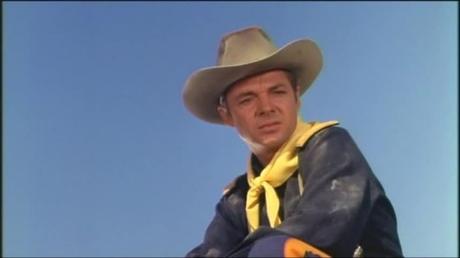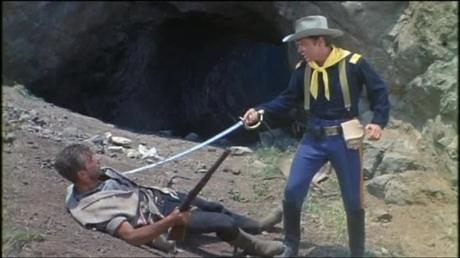
One of the great pleasures of blogging about movies is the way it has a habit of altering one’s plans in a positive way. Recent discussion put me in the mood to watch more William Witney, and the always fascinating tangential comments mentioned Audie Murphy and one of his films I hadn’t gotten round to. Apache Rifles (1964) is a film I’ve had sitting unwatched on my shelves for a while now and it’s one of the later films of both Witney and Murphy and has the added appeal, for me at least, of fitting into that transitional era for the western that has always interested me. The timing, casting and style are all noteworthy in any examination of this period of film history, and the picture itself is a tight and entertaining affair.
This highly fictionalized account sees Apache chief Victorio (Joseph Vitale) break out of the San Carlos reservation in protest at, among other things, the exploitation of the land and breaking of the treaties by unscrupulous gold miners. And so the hunt is on to bring these miscreants back, in this case led by a Captain Stanton (Audie Murphy), a soldier whose driven and implacable reputation precedes him, both among the troops under his command and the Apache he’s pursuing. Reputations are invariably won, and on occasion lost, for a reason; with Stanton, it all stems from his past and what he believes was his father’s misplaced trust in the word of the Indian. Embittered and determined not be played for a sucker in the same way, Stanton has taken a different path to his forebear and fully embraced his hatred for his enemy. In his eyes, the Apache is essentially sub-human, little more than an animal to be brought to heel by whatever means are necessary. Yet just as he achieves success in persuading Victorio to return to San Carlos, the seeds of self-doubt are sown by his encounter with Dawn Gillis (Linda Lawson), a missionary who has opted to live among the despised Apache. What’s worse, from Stanton’s point of view, is the attraction he feels towards this woman, especially in view of the fact she’s of mixed blood with a Comanche mother. Here we have the basis for an internal conflict, one that’s exacerbated by the unexpected shift in circumstances which takes place. At the precise moment when this unapologetic racist is on the point of questioning his own prejudice the carpet is whipped from beneath him. As ever, economic considerations influence political direction and Stanton finds himself pitched into something of a moral and emotional quandary. Stripped of his command, he can only look on as the scene is set for a bloody conflict between the wronged Apache and the manipulated cavalry, with his own moral and emotional well-being at stake.

Apache Rifles was made at the same time Sergio Leone was turning out A Fistful of Dollars and only a year before Sam Peckinpah would give us Major Dundee. In short, the western genre was in a state of flux at this point, and here we have a movie which is a reflection of that. The central theme of a man coming to terms with his own preconceptions and the reassessment of White/Indian relations harks back to the golden age of the 50s, while the tone and casting straddles the divide. As the 60s progressed, and the spaghetti western gained an ever stronger foothold on the consciousness of the audience, cynicism and a more casual attitude to violence would take root. Apache Rifles isn’t a cynical picture yet there’s a certain bitterness on show that presages what was looming over the horizon. Witney was an action director, an advocate of pace and punch, and there’s a frankness to his depiction of violence that would be built upon (or some might argue exploited) in the years to come. While there’s no explicit gore on display, there’s an acceptance of cruelty – a crucifixion and the torture of an a captive Apache. The film is by no means graphic compared to what would be the case in the future but there is a hard edge to it all the same. The location shooting, in Red Rock Canyon and Lone Pine, similarly recalls the classics of the 50s while simultaneously grounding it in realism.
All of which lead us on to the casting. Once again, there’s that sense of transition, particularly with the presence of Audie Murphy and L Q Jones. It’s impossible to think of Murphy without recalling the 50s, his wholesome persona fitting neatly into that more hopeful and optimistic time. But Murphy was far from simplistic, his war record and increasingly complex performances being proof of that. Given the right material, he was capable of the kind of brooding moodiness that grabs the attention. I think he was a fine actor who grew in stature with each successive picture, bringing a kind of coiled self-awareness to his roles. Taking the part of the principal villain is L Q Jones, a man who had already worked with Boetticher and Scott in Buchanan Rides Alone but who would go on to achieve greater fame in his films with Sam Peckinpah. His is a marvelously weaselly part, one with no redeeming features whatsoever. It’s also worth mentioning Michael Dante, who plays Victorio’s son and heir, a stoic and honorable figure throughout if perhaps a little too noble.

Apache Rifles is readily available on DVD, both in the US and the UK. The US edition comes via VCI – I imagine the Odeon UK disc replicates the transfer – and presents the film in its native 1.85:1 ratio. Overall, this is a good presentation of the film that is colorful and free of major distractions and damage. Happily, there are some worthwhile extra features included: there’s a gallery and trailers for some other VCI titles as well as some short featurettes. There are brief pieces on the Lone Pine museum and Michael Dante discussing his work with Witney, and then a more substantial piece on the position Apache Rifles occupies in the evolution of the genre. The latter includes some interesting information on the cast and crew of the movie. All told, this is an entertaining film, one of the last of what might be called the classic westerns. It’s certainly worth a look for anyone keen on the genre and the direction it was taking in the 1960s.
